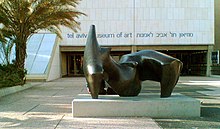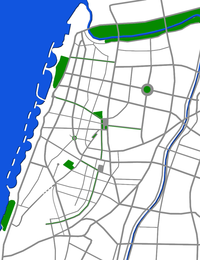Tel Aviv Museum of Art

|
|
The Tel Aviv Museum of Art ( Hebrew מוּזֵיאוֹן תֵּל אָבִיב לַאָמָּנוּת Mūsej'ōn Tel Avīv la-Ommanūt , German 'Tel Aviv Museum for Art' ) was opened on April 2, 1932 in the house of the first mayor of Tel Aviv , Meir Dizengoff . The museum then bore the name of his late wife, Tsina Dizengoff. In 1971 it moved to its current location in Rechov Scha'ul haMelech .
history
Tsina Dizengoff died in 1930. A year later, Me'ir Dizengoff left the shared house at Sderot Rothschild 16 in Tel Aviv and asked for it to be converted into a museum, "because a real city also needs a museum." He himself stayed in a small attic apartment of the house dwell. Karl Schwarz , from 1930 to 1933 head of the art collection of the Jewish Community in Berlin , officially called the Jewish Museum (Collection of the Jewish Community in Berlin) from 1932 , was appointed Museum Director at the suggestion of Dizengoff and General Director Mosche Kaniuk and therefore moved to Tel Aviv to build the museum.
Dizengoff, who finally died on September 23, 1936, confirmed his wish in his will in 1935: “My last request to the residents of Tel Aviv. I have dedicated a large part of my life to this city, and now that I am about to bid you farewell, I want to leave you my favorite child, the Tel Aviv Museum, in your custody. Please take good care of it, because one day it will become the pride and glory of our city. "
The building was expanded and renovated in the mid-1930s by the architect Carl Rubin (1899–1955), who, after his time in 1931/1932 as an employee in Erich Mendelsohn's architectural office in Berlin, settled in Tel Aviv as an independent architect and attracted attention through the first buildings from clients and the public. According to Rubin's plans, the Dizengoff house was converted for use by the cultural site expanded from the Tsina Dizengoff Museum to the Tel Aviv Art Museum . Rubin, who is well connected in the city, also won the tender to build the Beit Hadar in 1935 . Parallel to the renovation of the Dizengoffs 'house, Rubin was also involved in building the Beit Hadar , the headquarters of the citrus growers' association.
The museum reopened on February 23, 1936. Five days later, on February 28th, Rubin handed the Beit Hadar over to the owners. Schwarz writes about the conversion of the house into a museum: “After several years of preparatory work and the use of large funds, the expansion and new building of the museum can now be opened. The former Dizengoff house, one of the first buildings in Tel Aviv, which has undergone several changes over the years and which the mayor and founder of the museum, M. Dizengoff, made available, has been converted into a modern museum building according to the plans of the architect Carl Rubin has been redesigned. "
The exhibition area was expanded by 188 m² to 426 m², and the house received new, smaller windows, a redesigned entrance and a new facade. Schwarz describes the renovations and the great hall in which members of the National Council , the elected executive of the Jewish Palestinians , declared Israel's independence on May 14, 1948 . “On three floors, 15 large, specially adapted rooms and a large lecture hall were set up ... Through a vestibule you get into a transversely directed three-part hall, which is connected to two halls on each side, which mainly serve graphic exhibitions and which are around the walls running graphics cabinets are enclosed. A five-step staircase, which occupies the entire width and is interrupted by two pilasters, leads from the central hall to the large exhibition and lecture hall, which receives uniform, skylight-like lighting from narrow windows running close to the ceiling. This type of window arrangement, which protects against the sun and too much light, has been implemented throughout the building. The hall, with staggered podium and rows of chairs, offers 250 seats and is to be made available for art lectures and musical events. "
On the first floor there was a room for the exhibition of sculptures. On the floor above were offices and stores. Two rooms, the Liebermann Hall and the Lesser Ury Hall, were entirely dedicated to the works of these artists, but at that time the collection also comprised 350 paintings, 75 sculptures and more than 4,000 watercolors, hand drawings and original graphics, including works by Mark Matwejewitsch Antokolski , Leonardo Bazzaro , Marc Chagall , Edgar Degas , André Derain , James Ensor , Henri Epstein , Ernesto de Fiori , Vincent van Gogh , Maurycy Gottlieb , Isaac Israëls , Marie Laurencin , Wilhelm Lehmbruck , Isaak Iljitsch Lewitan , Max Liebermann , Claude Monet , Camille Pissarro , George Scharf , Lesser Ury , Maurice Utrillo or Maurice de Vlaminck .
collection
The museum houses a collection of classical and contemporary art, especially by Israeli artists. Individual buildings or parts of buildings are named after their respective patrons . For example, there is the Helena Rubinstein Pavilion for Contemporary Art (built in 1959), the Lola Beer Ebner sculpture garden , the Marc Rich and Gabrielle Rich Wing, and a youth wing called the Joseph and Rebecca Meyerhoff Art Education Center.
Works of the most important styles of the first half of the 20th century are exhibited: Fauvism , German Impressionism and Expressionism , Cubism , Futurism , Russian Constructivism , De Stijl and Surrealism with works by Joan Miró , French art from Impressionism and Late Impressionism to the Paris School with works by Chaim Soutine .
Among the exhibited artists are Max Ernst , Max Liebermann, Claude Monet, Emil Nolde , Max Pechstein , Camille Pissarro, Pierre-Auguste Renoir , Paul Cézanne , Alfred Sisley , Henri Edmond Cross , Pierre Bonnard , Tsuguharu Foujita , Henri Matisse , Amedeo Modigliani , Giorgio Morandi , Gustav Klimt , Wassily Kandinsky , Marc Chagall, Ernst Oppler , Maurycy Gottlieb and Reuven Rubin . You can also see works by Pablo Picasso from the Blue Period, the Neoclassical Period and his late works. The museum's Peggy Guggenheim collection, donated in 1950, includes 36 works by Jackson Pollock , William Baziotes , Richard Pousette-Dart , Yves Tanguy , Roberto Matta, and André Masson , among others .
Extension
On November 2, 2011, the new Herta and Paul Amir building was opened with the exhibition Schvirat ha-Kelim (שְׁבִירַת כֵּלִים Break of the vessels ) by the German artist Anselm Kiefer . The generous wing of the building was designed by the American architect Preston Scott Cohen . In the new building there are two rooms of 244 m², the gallery of the German friends . The Friends of the Tel Aviv Museum of Art, Germany made a financial contribution to the construction of the new building and wants to contribute to the exchange between German and Israeli museums.
Archive of Israeli Architecture
The new archive of the Israeli Architecture Gallery was opened in 2013.
Censorship charge
The opening of a joint exhibition by Ai Weiwei and Miki Kratsman on the topic of refugee camps around the world was planned for March 2015 . a. Portrait photos of three thousand Palestinians were to be shown. The exhibition has been postponed several times. Doron Sabag, a member of the Board of Trustees, allegedly urged Kratsman to "moderate the planned exhibition" in consideration of the current political climate. Kratsman accused the museum of censorship . The museum explained that the exhibition schedule for 2017 was already full, so it had not yet been possible to find a suitable date for the planned exhibition.
bibliography
- Karl Schwarz , "On the opening of the new museum in Tel Aviv", in: Palestine: Zeitschrift für den Aufbau Palestine , vol. 19 (1936), issue 3 (March 1936), Commission for the study of Palestine (ed.), P. 131-134 .
Web links
Individual evidence
- ↑ Mordecai Naor: Eretz Israel. The 20th century. Könemann, Cologne, 1998, ISBN 3-89508-594-4 , p. 173
- ↑ a b Joachim Schlör , Tel Aviv - from dream to city: Journey through culture and history , Frankfurt am Main: Insel, 1999, (= Insel Taschenbuch; Vol. 2514), p. 287. ISBN 978-3-458-34214 -4 .
- ^ Hermann Simon, The Berlin Jewish Museum in Oranienburger Strasse: History of a Destroyed Cultural Site (Berlin: Berlin Museum, 1 1983), Berlin: Union Verlag, 2 1988, pp. 18 and 36. ISBN 3-372-00197-4 .
- ^ Hermann Simon, The Berlin Jewish Museum on Oranienburger Strasse: History of a Destroyed Cultural Site (Berlin: Berlin Museum, 1 1983), Berlin: Union Verlag, 2 1988, p. 18. ISBN 3-372-00197-4 .
- ^ Hermann Simon , The Berlin Jewish Museum in Oranienburger Strasse: History of a Destroyed Cultural Site (Berlin: Berlin Museum, 1 1983), Berlin: Union Verlag, 2 1988, p. 36. ISBN 3-372-00197-4 .
- ^ Beit Dizengoff
- ↑ a b Karl Schwarz, "On the opening of the new museum in Tel Aviv", in: Palestine: Zeitschrift für den Aufbau Palestine , vol. 19 (1936), no. 3 (March 1936), Commission for the exploration of Palestine (ed.) , Pp. 131-134, here p. 131 .
- ↑ Edina Meyer-Maril (עֱדִינָה מֵאִיר – מָרִיל), The International Style Architecture in Tel Aviv 1930-1939 ,רָשׁוּת הַדֹּאַר / הַשֵּׁרוּת הַבּוּלַאי (Ed.), Tel Aviv-Jaffo: הַשֵּׁרוּת הַבּוּלַאי, 1994 / תשנ"ד, P. 2.
- ↑ a b Michael Jacobson (מִיכָאֵל יַעֲקוֹבְּסוֹן), "סִבּוּב בְּבֵית הָדָר", Chap. 4 'תּוֹלְדֹת', January 1, 2019 , in: חַלּוֹן אֲחוֹרִי: אַרְכִיטֶקְטוּרָה וְאִידֵאוֹלוֹגְיָה בְּדִּיסְנִיְלֶנְד מְקוֹמִי , accessed January 4, 2020.
- ^ Myra Warhaftig , you laid the foundation stone - life and work of German-speaking architects in Palestine 1918-1948 , Berlin: Wasmuth, 1996, p. 108. ISBN 978-3-8030-0171-9 .
- ↑ Nir Man (נִיר מַן) and Danny Recht (דָּנִי רֶכְט), "בֵּית הָדָר"(Beit Hadar), on: תֵּל אָבִיב 100. הָאֶנְצִיקְלוֹפֶּדְיָה הָעִירוֹנִי, accessed January 4, 2020.
- ↑ a b Karl Schwarz, "On the opening of the new museum in Tel Aviv", in: Palestine: Zeitschrift für den Aufbau Palestine , vol. 19 (1936), no. 3 (March 1936), Commission for the exploration of Palestine (ed.) , Pp. 131-134, here p. 132 . Omission […] and addition [n] not in the original.
- ↑ a b Karl Schwarz, "On the opening of the new museum in Tel Aviv", in: Palestine: Zeitschrift für den Aufbau Palestine , vol. 19 (1936), no. 3 (March 1936), Commission for the exploration of Palestine (ed.) , Pp. 131-134, here p. 133 .
- ↑ Karl Schwarz, “On the opening of the new museum in Tel Aviv”, in: Palestine: Zeitschrift für den Aufbau Palestine , vol. 19 (1936), no. 3 (March 1936), Commission for the exploration of Palestine (ed.), P 131-134, here p. 133seq .
- ↑ a b c Nellu Cohn: Tel Aviv Live . Melting Art / MPLS, Paris 2012, ISBN 978-2-84828-219-0 , pp. 42 .
- ↑ Tel Aviv Museum of Art opens new wing with Anselm Kiefer exhibition. (No longer available online.) German Embassy Tel Avi, formerly in the original ; Retrieved February 11, 2012 . ( Page no longer available , search in web archives ) Info: The link was automatically marked as defective. Please check the link according to the instructions and then remove this notice.
- ↑ Kelly Minner: Tel Aviv Museum of Art / Preston Scott Cohen. archdaily.com, May 24, 2011, accessed February 11, 2012 .
- ↑ "bridge to Israel," in the world on Sunday , October 30th 2011, page BY3
- ↑ Shany Littman: "Tel Aviv Museum Nixes Ai Weiwei Exhibit; Israeli Artist Says Censorship at Play", in: Haaretz , February 4, 2016.
Coordinates: 32 ° 4 ′ 38.8 " N , 34 ° 47 ′ 12.6" E

